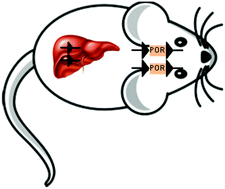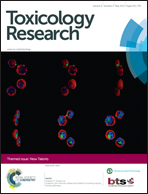The Hepatic Reductase Null (HRN™) and Reductase Conditional Null (RCN) mouse models as suitable tools to study metabolism, toxicity and carcinogenicity of environmental pollutants†
Abstract
The cytochrome P450 (P450) superfamily consists of a large number of haem-containing mono-oxygenases that play a pivotal role in the metabolism of many drugs and carcinogens. A number of gene knockout and transgenic mice have been developed to study the role of specific P450 isoenzymes in xenobiotic metabolism, but the functional redundancy inevitably found in the P450 gene superfamily make it difficult to determine the in vivo role of these enzymes in xenobiotic metabolism as a whole. Over ten years ago the Hepatic Reductase Null (HRN™) model was developed to overcome these limitations. In these mice cytochrome P450 oxidoreductase (POR), the electron donor to P450 enzymes, is deleted specifically in hepatocytes, resulting in the loss of essentially all hepatic P450 function. While the HRN model uses an hepatocyte-specific albumin promoter to drive POR deletion during mouse development to adulthood, adult Reductase Conditional Null (RCN) mice are entirely normal with respect to POR (and thus P450 function) until hepatic POR deletion is driven via a CYP1A1 promoter which is induced by treatment with the polycyclic aromatic hydrocarbon 3-methylcholanthrene, essentially recapitulating the phenotype of the HRN mouse. The HRN and RCN models have been used to study the metabolism and genotoxicity of a variety of environmental carcinogens including benzo[a]pyrene, aristolochic acid, 3-nitrobenzanthrone and 2-amino-1-methyl-6-phenylimiazo[4,5-b]pyridine and the results obtained are summarized in this review. For example, investigations of BaP metabolism in the HRN and RCN mice revealed an apparent paradox, whereby hepatic P450 enzymes appeared to be more important for detoxification of BaP in vivo, despite being involved in its metabolic activation in vitro. Cytochrome b5 is a microsomal haemoprotein which provides electrons (from cytochrome b5 reductase) to P450 enzymes; however, its role in carcinogen metabolism is still enigmatic. Therefore, a mouse line was generated with a conditional hepatic deletion of cytochrome b5 (HBN, Hepatic cytochrome b5 Null) that was also crossed with HRN mice to create a double conditional mutant, HBRN (Hepatic cytochrome b5/P450 Reductase Null), in which both enzymes are deleted specifically in the liver. The combination of the HRN, RCN, HBN and HBRN models provide a powerful approach to study the P450-dependent metabolism and (geno)toxicity of environmental carcinogens.

- This article is part of the themed collection: New Talents

 Please wait while we load your content...
Please wait while we load your content...